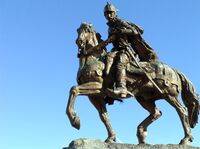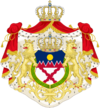Grand Duchy of Colorado
Grand Duchy of Colorado Magnus Ducatus Colorado (Latin) Großherzogtum Colorado (German) Gran Ducado de Colorado (Spanish) | |||||||||
|---|---|---|---|---|---|---|---|---|---|
| Motto: "Nil sine numine" Nothing without the divine will | |||||||||
| Capital and largest city | Denver | ||||||||
| Official languages | English, Latin | ||||||||
| Recognised national languages | German, Spanish | ||||||||
| Religion | Pluralism (official) | ||||||||
| Demonym(s) | Coloradan | ||||||||
| Government | Unitary semi-constitutional monarchy | ||||||||
| Friedrich von Colorado | |||||||||
| Johann von Colorado | |||||||||
| Legislature | Legislative Assembly | ||||||||
| Independence from the United States | |||||||||
• Declaration | 25 March 2022 | ||||||||
| 24 April 2022 | |||||||||
• Republic | 29 October 2023 | ||||||||
| Area | |||||||||
• Total area | 269,837 km2 (104,185 sq mi) | ||||||||
• Water (%) | 0.36% | ||||||||
| Population | |||||||||
• 2022 estimate | 5,773,714 (claimed) 22 (official) | ||||||||
| Currency | United States Dollar (USD) | ||||||||
| Date format | dd/mm/yyyy (CE) | ||||||||
| Driving side | right | ||||||||
| Calling code | +1 | ||||||||
| |||||||||
Colorado, officially the Grand Duchy of Colorado (Latin: Magnus Ducatus Colorado, German: Großherzogtum Colorado, Spanish: Gran Ducado de Colorado), was a landlocked, self-proclaimed sovereign state commonly known as a micronation by external observers. Located in the Southwestern United States, it was entirely landlocked within the region of Colorado. Colorado was a unitary semi-constitutional monarchy, with the Grand Duke being the monarch. The capital and largest city was Denver. Colorado had two official languages, English and Latin, and two nationally recognised languages, German and Spanish. Colorado was founded and declared its independence on 25 March 2022.
On 27 October 2023, the Grand Duchy held a referendum on whether to transition into a republic. The measure was adopted and the nation became the Republic of Colorado.
History
Pre-European settlement

Long before European settlement, Colorado was inhabited by Native Americans for over 13,000 years. Sites across Colorado contain artefacts dating from 11,200 BC to 3,000 BC. The eastern edges of the Rocky Mountains were a major route for migration that was important for the early spread of Natives Americans throughout the Americas. Ancient Puebloans lived in the valleys and mesas of the Colorado Plateau. The Ute Nation inhabited the mountain valleys of the Southern and Western Rocky Mountains and even as far as the Front Range of present day. The Apache and Comanche also inhabited the eastern and southeastern parts of Colorado. At times, the Arapaho and Cheyenne Nations moved west to hunt across the High Plains.
European settlement & the USA

Colorado was claimed by the Spanish Empire as part of the Viceroyalty of New Spain. Following the Louisiana Purchase in 1803, the United States gained a claim on the eastern Rocky Mountains. The United States won against Mexico in the Mexican-American War, leading to the signing of the Treaty of Guadalupe Hidalgo, which saw the entirety of Colorado along with northern Mexico be annexed by the United States. Colorado was organised as a territory by an Act of Congress on 28 February 1861, by outgoing President James Buchanan. Colorado saw organised militias participate in the American Civil War, which marched from Denver to Glorieta Pass, New Mexico. This resulted in the Battle of Glorieta Pass, where the Union had won strategically, resulting in the Texan forces retreating to Santa Fe. As a result of the battle, the Texan forces had lost significant amounts of their supplies and saw little support in New Mexico, leading to their abandonment of Santa Fe for San Antonio. Following this, the Confederacy did not attempt further attempts to occupy the southwestern United States.
Colorado was admitted to the Union on 1 August 1876, four weeks after the centennial anniversary of the United States' existence, earning it the moniker "Centennial State". It was proclaimed the 38th state by President Ulysses S. Grant. Colorado made history on 7 November 1893, by becoming the second state to grant suffrage to women. Following its admission, Colorado was consistently a pro-Republican state, though at times it significantly supported the Democratic Party.
Late Colorado history


In the 1920s, the Colorado Klan Realm achieved dominance in Colorado politics. However, efforts by several non-klan lawmen and lawyers saw the rapid decline in the organisation's power, losing dominance by the end of the 1920s. Colorado was also the first western state to host a major political convention when, in 1908, the Democratic Party met in Denver. In 1930, the population of Colorado was recorded to be over one million. Colorado suffered greatly throughout the Great Depression and Dust Bowl, but a major wave of immigration following World War II lessened the effects of both events. Colorado is also considered to be the birthplace of the Chicano Movement. Colorado was also the first state to lessen restrictions on abortions when Republican Governor John Love signed a law lessening restrictions. Colorado had also been the site of several significant shootings, including the Columbine High School massacre, the 2012 Aurora, Colorado shooting, and the 2021 Boulder shooting. In recent history, Colorado had become more supportive of the Democratic Party, with the last Republican governor being elected in 2002 and Republicans holding both Senate seats in 2004.
Declaration of Independence and present day
On 25 March 2022, Friedrich von Colorado declared Colorado's independence from the United States as the Grand Duchy of Colorado. Friedrich established the House of Colorado to serve as the reigning dynasty of Colorado. Friedrich presented the Constitution of Colorado on 5 April 2022, 4 days after the opening of the 1st Legislative Assembly. The Constitution would be ratified on 24 April 2022.
Government and Politics
Main article: Constitution of Colorado
Monarchy
Main articles: House of Colorado, and Monarchy of Colorado
The Grand Duke combines legislative, executive, and judicial functions, and royal decrees form the basis of the country's legislation. The title of Grand Duke was held by and bound to the House of Colorado. The royal family dominates the political system. The family's vast numbers allow it to control most of the kingdom's important posts and to have involvement and presence at all levels of government. All key positions in the government are generally reserved for the royal family, as are the 2 marquisates and 4 counties.
Prime Minister
Main article: Prime Minister of Colorado
The premiership of Colorado was generally reserved for a senior member of the House of Colorado. Typically, this senior member was the heir presumptive to the Grand Duke of Colorado, and likewise, the Marquess of Greater Colorado was generally considered the most important peerage of the Grand Duchy. Though the prime minister was not the head of government, it was the presiding officer of the Legislative Assembly and the senior-most member of the cabinet of first ministers, the executive cabinet of Colorado.
Legislative Assembly
Main article: Legislative Assembly (Colorado)
The Legislative Assembly serves as the formal advisory body to the Grand Duke of Colorado. Despite having no official legislative powers, it can, however, propose legislation to the Grand Duke to be approved by the Grand Duke and his Cabinet. The Legislative Assembly itself cannot approve and enforce legislation. The 1st Legislative Assembly was opened on 1 April 2022.
Judiciary
Main articles: Court of Magistrates (Colorado), Chief Magistrate (Colorado), and Assembly of Magistrates (Colorado)
The judiciary was composed of the Court of Magistrates, the supreme judiciary body, and the Assembly of Magistrates, certified lawyers and attorneys that are permitted on the Court of Magistrates bar. The Chief Magistrate serves as the head of both the Court and the Assembly of Magistrates. Members of the Court of Magistrates are appointed by the Grand Duke, whereas members of the Assembly of Magistrates are appointed by the Chief Magistrate. The Chief Magistrate was also reserved for senior members of the House of Colorado.
Peerage titles
The Grand Duchy of Colorado consists of 2 marquisates, and 4 counties, which are generally reserved for the royal family. On 4 April 2022, Friedrich von Colorado claimed the titles of Count of Springs and Count of Grand Junction.
- Marquisate of Greater Colorado, The Right Honourable, His Royal Highness Crown Prince Johann von Colorado, Hereditary Grand Duke, Prime Minister of Colorado, and Marquess of Greater Colorado
- County of West Denver, The Right Honourable, Her Royal Highness Princess Sabina von Colorado, the Deputy Prime Minister of Colorado, and Countess of West Denver
- County of East Denver
- Marquisate of Lesser Colorado, The Honourable, Her Excellency Lady Franziska von Huffertz, Marquise of Lesser Colorado
Foreign relations
Main Article: Foreign relations of Colorado
Bilateral
| Micronation | Begin | Status |
|---|---|---|
| 25 March 2022 | Formal |
Military
On 25 April 2022, Friedrich von Colorado issued a royal decree banning national, private, or public militaries, militias, and other armed groups. The ban was justified on the basis of valuing lives, the unnecessary violence that these groups bring, and the maintenance of national internal stability. The punishment for breaking the decree was a $100 fine and a 1-year exile, which includes the stripping of citizenship, honours, positions, and titles. Unofficially, the Grand Duchy of Colorado had adopted a neutral, noninterventionist, and pacifist policy regarding war.
Geography
Colorado is notable for its diverse geography, which includes alpine mountains, high plains, deserts with huge sand dunes, and deep canyons. In 1861, the United States Congress defined the boundaries of the new Territory of Colorado exclusively by lines of latitude and longitude, stretching from 37°N to 41°N latitude and from 102°02′48″W to 109°02′48″W longitude (25°W to 32°W from the Washington Meridian). After 161 years of government surveys by the United States, the borders of Colorado were officially defined by 697 boundary markers and 697 straight boundary lines.
Climate

The climate of Colorado is more complex than that of states outside of the Mountain States region. Unlike most other states, southern Colorado is not always warmer than northern Colorado. Most of Colorado is made up of mountains, foothills, high plains, and desert lands. Mountains and surrounding valleys greatly affect the local climate. Northeast, east, and southeast Colorado are mostly the high plains, while Northern Colorado is a mix of high plains, foothills, and mountains. Northwest and west Colorado are predominantly mountainous, with some desert lands mixed in. Southwest and southern Colorado are a complex mixture of desert and mountain areas.
Demographics
Ethnicity
| Race and Ethnicity | Non-Hispanic | Total |
|---|---|---|
| White (non-Hispanic) | 65.1% | 69.4% |
| Hispanic or Latino | - | 21.9% |
| Black (non-Hispanic) | 3.8% | 4.9% |
| Asian | 3.4% | 4.7% |
| Native American | 0.6% | 2.1% |
| Pacific Islander | 0.2% | 0.4% |
| Other | 0.5% | 1.5% |
| Race and Ethnicity | Non-Hispanic | Total |
|---|---|---|
| White (non-Hispanic) | 95.45% | 100% |
| Hispanic or Latino | - | 4.55% |
Language
English and Latin are the official languages of Colorado, despite Spanish being more widely spoken than Latin. Spanish and German are nationally recognised languages due to their historical connections to Colorado, with Spanish being the language of New Spain and Mexico, which formerly controlled Colorado during the colonial era, and German being the largest non-Hispanic ethnic group in Colorado. Officially, all royal positions are named in Latin, whereas the national name was in English. English translations of royal positions are permitted and widely encouraged by the royal government.
Religion
Formerly, the Wesleyan theology and the Wesleyan Church were the state religions; however, upon the ratification of the Constitution of Colorado, the official state religion was abolished, and state pluralism was adopted. The decision was made to be incorporated into the constitution based on the mostly agnostic and atheist population of Colorado.
Culture
The culture of the Grand Duchy of Colorado was very similar to that of pre-Independence Colorado. The most prominent aspects of Coloradan culture are its marijuana and LGBT communities, which have a dominant impact on the overall culture. There are several other major aspects of Coloradan culture, which include its appreciation for sports, its massive cuisine culture, and its wine and beer culture.

